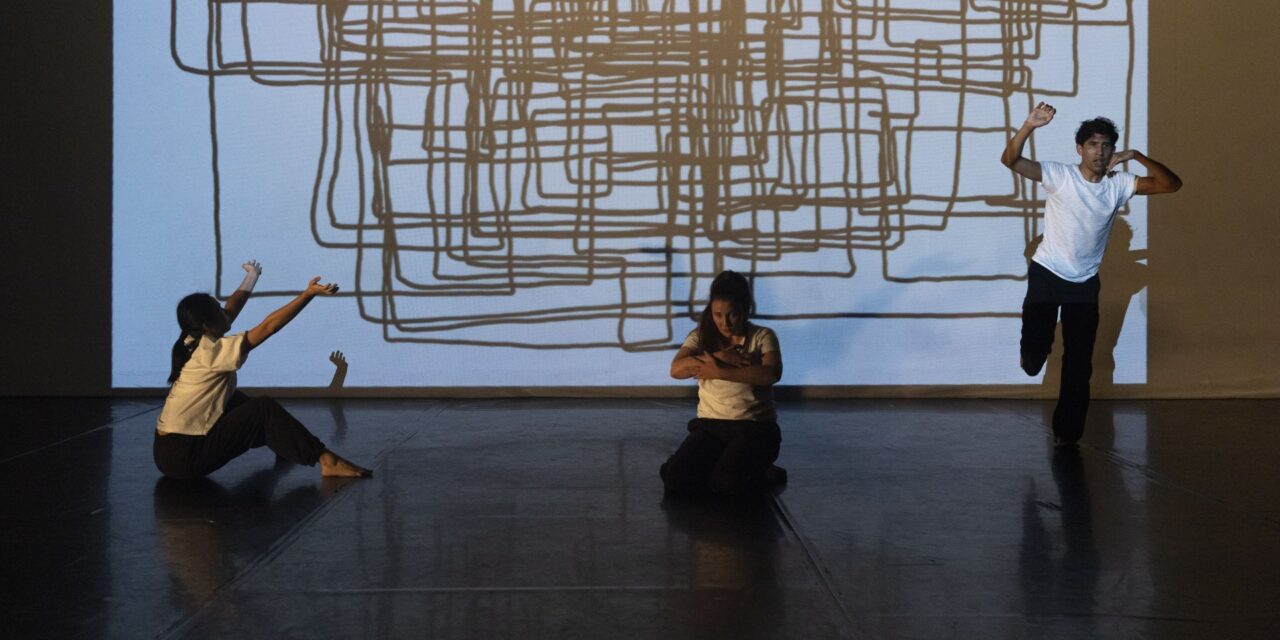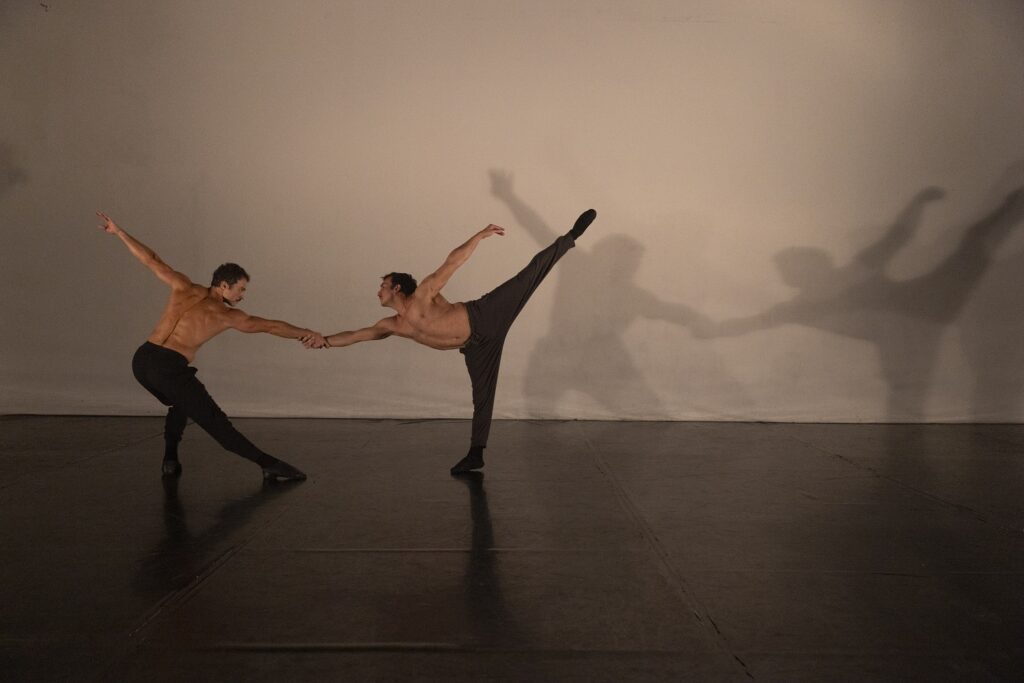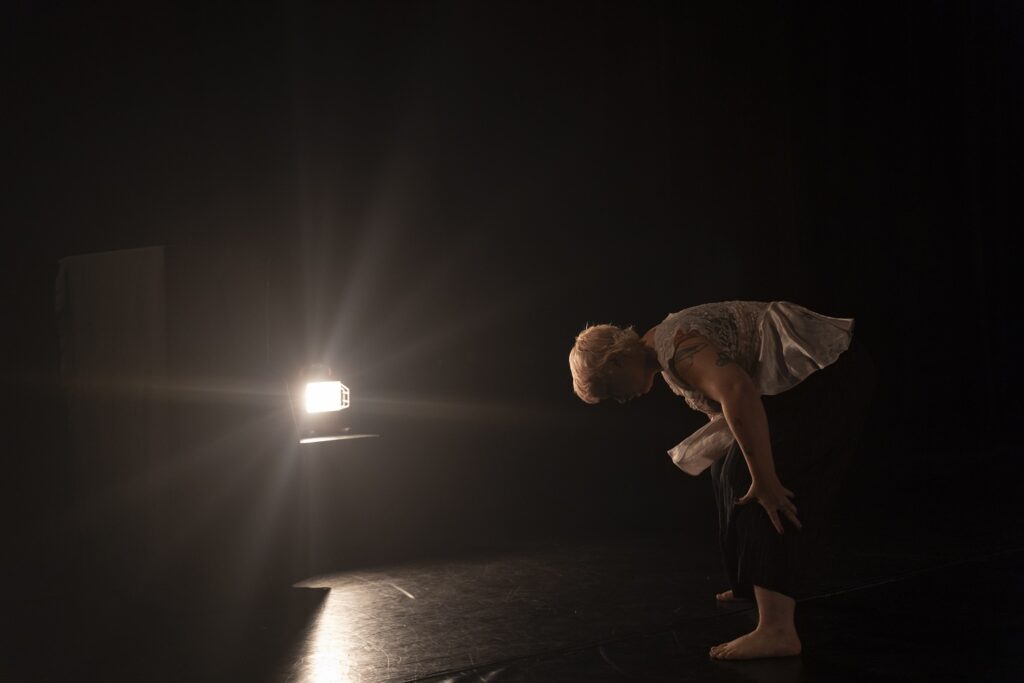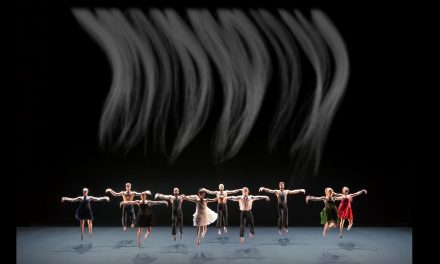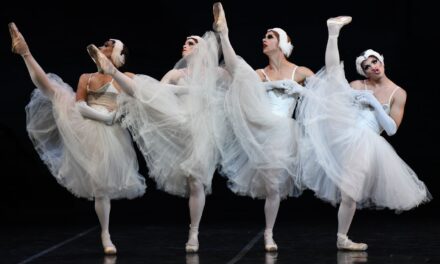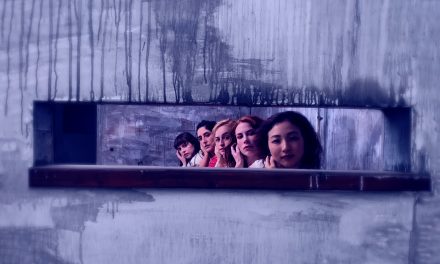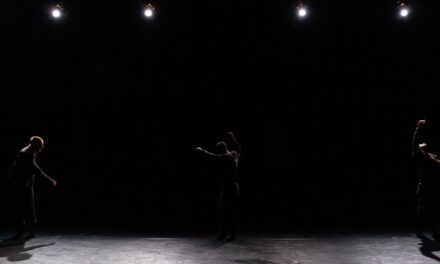On June 28, 2025 at Brockus Studios, I enjoyed the chance to see a showing of works that came out of Brockus’ MATCH Residency. This new residency is an effort by Deborah Brockus to give dancers a chance to dance and choreographers a chance to create, and the program matched 12 pre-selected choreographers with 45 dancers who showed up to audition. Last weekend, I saw two of the works during their second weekend of shows, and on this night, I was able to see seven more of the pieces.

MATCH Residency – Amanda Harris, Carmen Tienda, John-Pierre Cardenas, Sophie Kim, Vernice Edhilao, and Victoria Renteria in “Legless Birds” by Valkyrie Yao – Photo by Don Hannah.
Starting off the evening was Valkyrie Yao’s “Legless Bird,” which was a well-paced work based on the idea of being adrift like a legless bird who does not have the ability to land and find a place to rest his soul. The six dancers were dressed in neutral tones and wore button downs, which was utilized to represent wings throughout the piece; when the lights came up, the dancers were folded over in child’s pose with their shirts over their arms and head taking the shape of fluttering wings. The dance featured motifs of quivering hands and undulating wing-like arms, as well as fluid phrases of floorwork and layered arrangements of movement. Yao used the simple technical abilities of the space well, at one point having a dancer execute flapping arms directly in front of a light to project giant shadows on the back wall. As the piece built to an end, the dancers joined in for a pulsing section featuring passionate stomps and flails. Yao successfully used concepts of impulse and stillness in her movement choices which gave the phrases punctuation that contrasted with the more flowing music. The dancers found and lost each other along their journey, never quite interacting with eye contact, but acting more like birds finding one another in the currents of the wind. The lights faded on the visual of the dancers in a clump, repeating the same stylized leg action on their own time. They are still individual restless souls but have found a sense of togetherness on their journey. The dancers were Amanda Harris, Carmen Tienda, John-Pierre Cardenas, Sophie Kim, Vernice Edhilao, and Victoria Renteria.
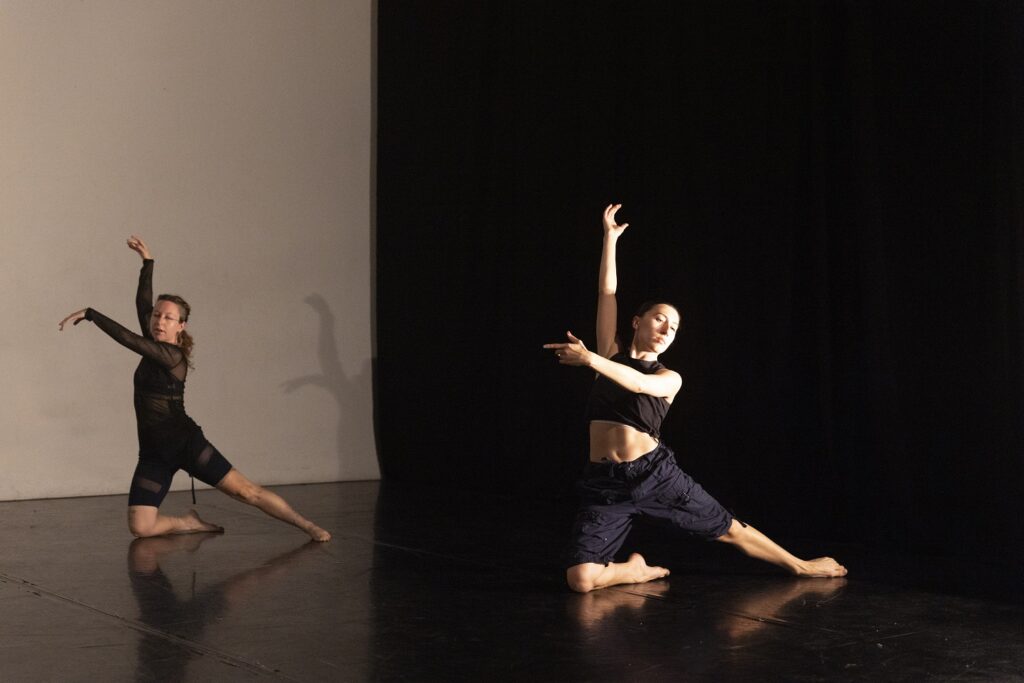
MATCH Residency – L-R Carmen Tienda, Zoe Foy “Parade of the Subconscious” by Summer Lee – Photo by Don Hannah.
Summer Lee’s quartet titled “Parade of the Subconscious” was performed by Zoe Foy, Bruna Gill, Carmen Tienda, and Melody Wilson. It was inspired by bringing the shapes and colors of a painting to life – with Brockus’ AC fans being used, I struggled to hear some of the introductions in their entirety and didn’t catch the name of the painting. The dancers wore simple outfits – mostly in black, but with two dancers in different colored pants. I’m not sure if the costume was referencing the painting “The Harlequin’s Carnival” by Joan Miró, but it didn’t feel cohesive, and it may have been stronger to have the dancers in all black, letting the dancing bring the colors of the painting to life. The piece started with more peaceful, ballet-influenced unison work, with a shift coming as spoken word was added to the soundscore and the dancers wandered the space becoming individuals. The dancers were technically strong and moved well together through unison phrases, canons, and moments of layered individual phrasework. Lee used interesting movement pathways, and I liked how at times she used repetition, similar to an artist repeating a brushstroke to lay down a darker line. I did find the beginning part of the piece a bit disconnected and less impactful. With the four moving in unison and primarily facing front, it felt more like a classroom exercise.
The third piece of the evening was an additional work that was not a part of the MATCH Residency. “BROS” was choreographed by John Castagna and performed by Omri Mishael and Ottavio Taddei. The work was very ballet-influenced, with sharper arm shapes instead of softly curved ballet arms. “BROS” showed a tale of two men starting separately and finding their way to connecting after sizing each other up while watching each other dance. Castagna used powerful, angular shapes in his choreography, and his dancers were strong and technical movers. For this viewer, the choreography stayed at the same tempo and pacing throughout and could have been made more dynamic by playing with musicality in order to contrast the steady pulse of the accompaniment. Because there was a theme of showing off for each other, it would have been exciting to see the dancers take more risks in their movement as if they were motivated to one up each other.
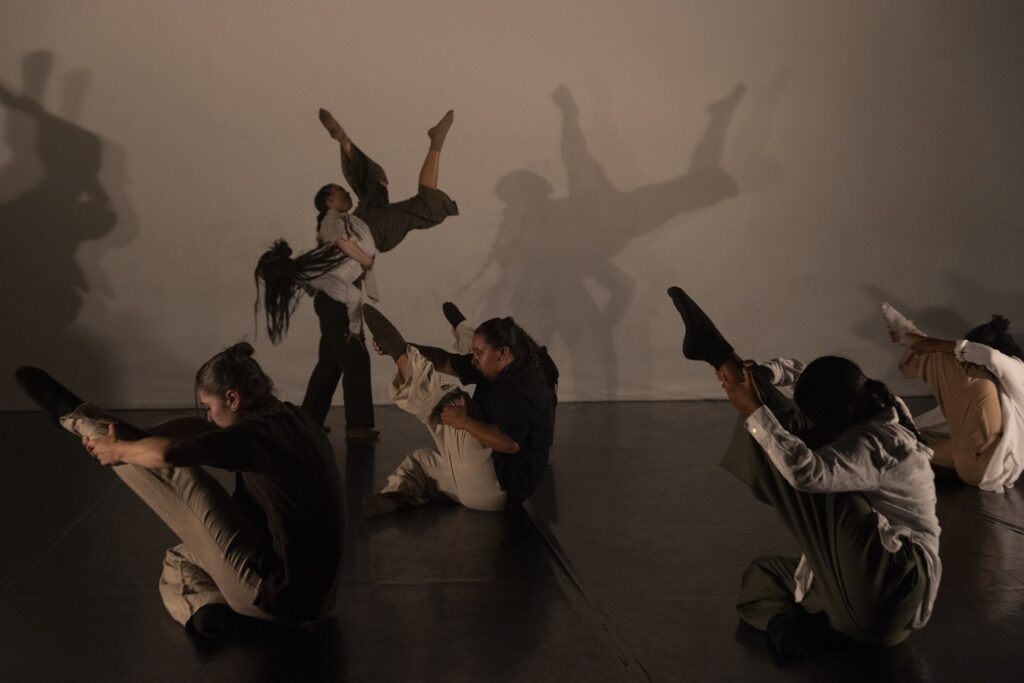
MATCH Residency – Lael Battiste, Niketa Kon, Maya Peterson, Melissa Valenzuela, Rivka Villanueva, Cheryl Wei, Melody Wilson, and Kate Zipper in “When I let you in” by Margaux Gex – Photo by Don Hannah.
The compelling last piece of the first act was Margaux Gex’s “When I let you in,” danced by Lael Battiste, Niketa Kon, Maya Peterson, Melissa Valenzuela, Rivka Villanueva, Cheryl Wei, Melody Wilson, and Kate Zipper. Gex explored the complexity of human connections and how we can feel alone while surrounded by others. The work was dynamic, well-arranged, and strongly executed. I loved Gex’s floorwork, which featured weaving limbs and detailed isolated moments. She repeated the same phrase multiple times, arranging things differently, showing how we can get stuck on an idea or the way someone might play out multiple scenarios in their head. The dance progressed into an exploration of partnerwork and the beginnings of finding connections, using similar arrangement methods where the group would all move, then freezing in place to let one individual or pair have their own exploration on the theme. The piece ended with one last picture of the dancers in a circle, twisting outward and leaning their heads on each other.
Maryam Malmir’s “The Loop” explored mathematical patterns brought to life through dancing. Projected on the back wall was a graphic of a black line being drawn, taking sharp turns at seemingly random times, creating an increasingly layered jumble. The five dancers walked, taking sharp turns periodically, and I was able to follow how they were tracing the patterns projected on the wall. The piece slowly built, adding gestures to the walking, then transforming into skips, crawls, and kicks. Based on Malmir’s introduction about patterns, I found myself wondering what moments were planned and what was a chance syncing up of the dancers’ individual patterns. In one part, after the grid of angular pathways had been broken, the dancers writhed on the floor with a shared pulse before slowly separating as they continued their individual repeating motifs. Malmir’s choreography featured unique initiations, as if the dancers were being controlled by an outside force that would jolt their knees sideways causing a deep plié to fall to the floor. The dancers seemed to have their own instructions and patterns to follow, though the piece still had larger ebbs and flows of chaos and calm. It was entrancing in a confusing way. The piece was danced by Arturo Gonzalez, America Goetten, Jaymie Valentine, Vernice Ednilao, and Zoe Foy.
“Damage” by Chorong Yang was a solo created in collaboration with the dancer, Jules Mara. Yang invited the audience to find their own narrative in the piece. Mara was an exquisite performer and Yang’s choreography was a unique take on the organ music by Bach, with Mara using heavy gestures, pulling at themself, and repeating scoots or slides on the floor. Walking, particularly in a circle around the space, was a repeating transitional motif between sections of movement. At times, I wanted to feel more tension in moments of stillness to keep Mara’s presence felt. I enjoyed the contrast of their luscious, expansive movement quality with more broken down, piece by piece constructions of shapes, and they commanded the space as the only solo of the evening incredibly effectively.
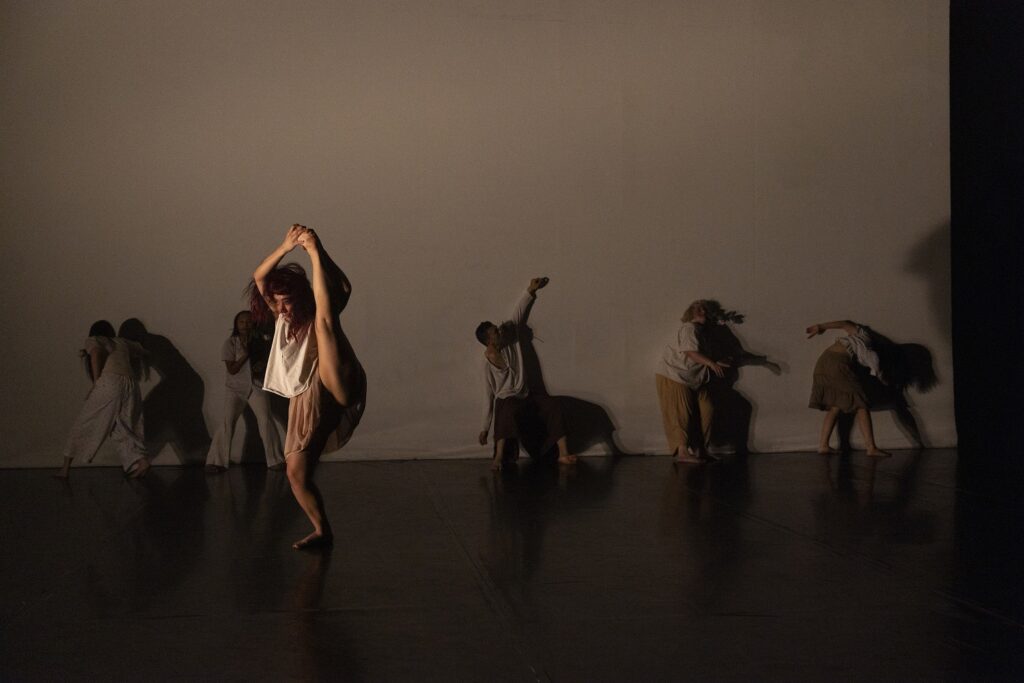
MATCH Residency – Alondra Zitlaly Perez, Amanda Harris, Cheryl Wei, Lisa Shen, Theresa Reish, Thomas Ng, and Vernice Ednilao in “La Voz de la Gente” by Santiago Rivera – Photo by Don Hannah.
With the most memorable introduction of the evening, declaring their piece as a critique on our current president (this was met with applause) and showing off the message of FUCK I.C.E. on the back of their shirt, Santiago Rivera was up next with “La Voz de la Gente.” Their cast was made up of Alondra Zitlaly Perez, Amanda Harris, Cheryl Wei, Lisa Shen, Theresa Reish, Thomas Ng, and Vernice Ednilao. The work started with a memorable tableau: five dancers pressed facefirst into the back wall with their hands up, one dancer on the floor curled around one of the dancer’s feet at the wall, and the final dancer stood shaking in the center of the space. Each dancer had a pink rose in their mouth. The beauty of the rose in the mouth contrasted with the idea of the dancers being made voiceless. The dancers moved slowly and were always shaking uncontrollably as they moved, showing a slow, raw, emotional struggle. The piece felt like a slow motion scream. At times, the dancers found each other, desperately grabbing at one another or clumping together. Rivera used the space well and his dancers were extremely committed to the very specific movement quality.
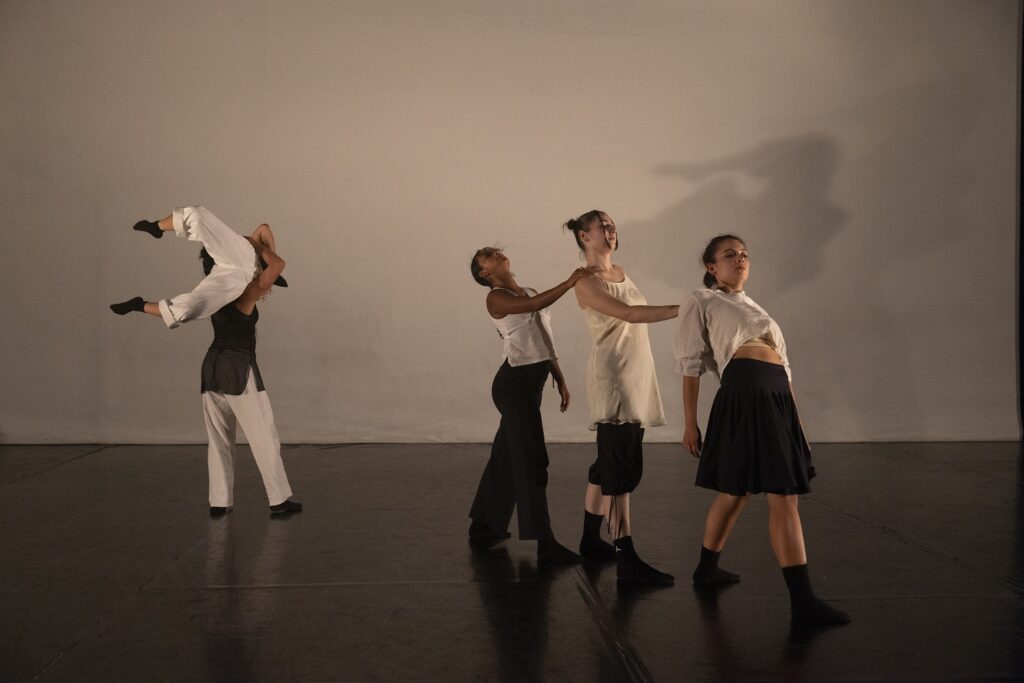
MATCH Residency – Niketa Kon, Victoria Renteria, Carmen Tienda, Melissa Valenzuela, and Kate Zipper in “Unfolding” by Emily O’Rourke and Tanz Tanz Revolution – Photo by Don Hannah.
Capping off the night was the intricate “Unfolding” by Emily O’Rourke and Tanz Tanz Revolution which explored moving out of uncertainty. The piece started with the dancers piled on the floor, and my attention was immediately drawn when they stood up as if falling in reverse. Like many other choreographers in this show, O’Rourke did a great job arranging the choreography, often having dancers stop and start at different times creating an evershifting yet continuous flow of actions. The choreography had excellent use of the spine to create dynamic movements and great moments of smooth, almost weightless ascent from the floor, like the moment at the beginning. I also enjoyed the interesting, intertwining lifts that felt like there was a motif of climbing others, almost as if seeking a new viewpoint or perspective. While the movement and execution was great, I would have loved seeing more of the journey on the dancers’ faces. The choreography was complex and detailed, and I think that there could have been more intention with making that small tics and hand placements represent uncertainty and self-doubt rather than just feel like complexity for its own sake. The dancers were Niketa Kon, Victoria Renteria, Carmen Tienda, Melissa Valenzuela, and Kate Zipper.
This showcase was an impressive exhibition of the creativity that the MATCH Residency created a space for, and I hope this is a program that will continue to offer an outlet for both dancers and choreographers to come together in creativity.
For more information about Brockus Project Dance, please visit their website.
Written by Rachel Turner for LA Dance Chronicle.
Featured image: MATCH Residency – Arturo Gonzalez, America Goetten, Jaymie Valentine, Vernice Ednilao, Zoe Foy in “The Loop” by Maryam Malmir – Photo by Don Hannah.

